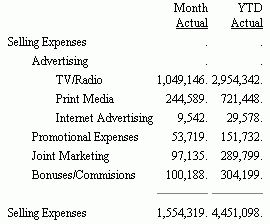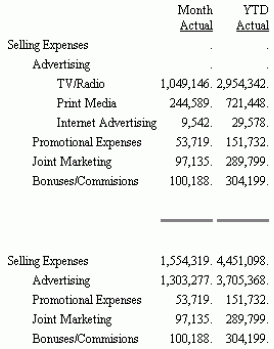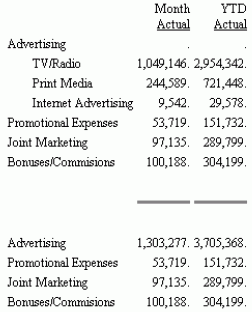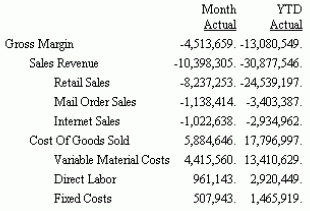Consolidating an FML Hierarchy
|
How to: |
The ADD command consolidates multiple levels of the hierarchy on one line of the FML report output. You can use ADD alone or in conjunction with GET CHILDREN or WITH CHILDREN. Note that ADD is designed to work with requests that use the SUM command. It is also designed to be used with detail-level data, not data that is consolidated.
When used alone, ADD aggregates the parent and children on one line of the report output, summing the numeric data values included on the line. This corresponds to the FML syntax parentvalue or CHILD1 OR CHILD2 OR ...
When used in conjunction with GET CHILDREN, ADD displays one line for each child of the specified parent value. Each line is a summation of that child and all of its children. You can specify the number of levels of children to display (which determines the number of lines generated on the report output) and the depth of summation under each child. By default, only direct children have a line in the report output, and the summary for each child includes all of its children.
When used in conjunction with WITH CHILDREN, ADD first displays a line in the report output that consists of the summation of the parent value and all of its children. Then it displays additional lines identical to those displayed by GET CHILDREN ADD.
In order to use a data record in more than one line of an FML report (for example, to display both detail and summary lines or to consolidate detail data at multiple levels), the following setting is required:
SET FORMULTIPLE=ON
Syntax: How to Create One Summary Row for an FML Hierarchy
TABLE FILE filenameSUM ... FOR hierarchyfld parentvalue ADD [n|ALL] [AS CAPTION|'text'] [LABEL label] . . . END
where:
- filename
-
Is the name of the file to be used in the FML request. If the hierarchy for this request cannot be loaded automatically, it must have been loaded previously by issuing the LOAD CHART command.
- hierarchyfld
-
Is the hierarchy field name. If the request references a joined structure, the name must be the field name from the host file. The alias name is not supported.
- parentvalue
-
Is the parent value that determines the starting point in the hierarchy for the aggregation.
- ADD
-
Displays the parent and n levels of its children on one row, summing the numeric data values displayed on the row. This corresponds to the FML syntax parentvalue or CHILD1 OR CHILD2 OR CHILD3 and more, if applicable.
To display the sum of just the children, you must display the parent row, display the summary row, and use a RECAP to subtract the parent row from the sum. For example:
FOR ... parentvalue OVER parentvalue ADD 1 OVER RECAP CHILDSUM = R2-R1;
- n|ALL
-
Is a positive integer from 1 to 99, specifying the number of levels of the hierarchy to aggregate. ALL is the default value. Therefore, if n is omitted, all children are included in the sum. If n is 1, only direct children are included. If n is 2, direct children and grandchildren are included. ADD 99 includes up to 99 levels of children. ALL is a synonym for 99.
- CAPTION
-
Indicates that the caption of the parent value displays for the total row.
Note that the AS CAPTION phrase is supported for tagged rows, including those that do not use the GET CHILDREN or ADD syntax. However, the hierarchy must be defined (by specifying the PARENT_OF attribute) in order to load and display the caption values. If the hierarchy is not defined, the AS CAPTION phrase is ignored.
- 'text'
-
Is a text string to use as the row title for the aggregate row. The CAPTION field defined in the Master File is not used as the caption on the report output.
- label
-
Is an explicit row label. Each generated row is labeled with the specified label text.
Example: Displaying One Summary Line for an FML Hierarchy
The CENTSYSF data source contains detail-level financial data. To use the account hierarchy in the CENTGL data source with this financial data, the two data sources are joined. The data in CENTSYSF is stored with natural signs, which means, in financial terms, that revenues and liabilities are stored as negative numbers. The portion of the hierarchy used in this request contains only positive data.
Note that the join is not required to be unique, because the hierarchy is defined in the host segment.
First the WITH CHILDREN command displays the lines of the hierarchy starting with account Selling Expenses (3100). Note that only accounts with no children are populated in this detail-level data source. The ADD command then creates one line that is the sum of account 3100 and all of its children.
SET SHOWBLANKS=ON SET FORMULTIPLE=ON JOIN SYS_ACCOUNT IN CENTGL TO ALL SYS_ACCOUNT IN CENTSYSF TABLE FILE CENTGL SUM NAT_AMOUNT/D10.0 NAT_YTDAMT/D10.0 FOR GL_ACCOUNT 3100 WITH CHILDREN ALL AS CAPTION OVER BAR OVER 3100 ADD AS CAPTION IF PERIOD EQ '2002/03' END
The output is shown as follows.

Syntax: How to Consolidate FML Hierarchy Data to Any Level and Depth
TABLE FILE filename
SUM ...
FOR hierarchyfld
parentvalue {GET|WITH} CHILD[REN] [n|ALL] ADD [m|ALL]
[AS CAPTION|'text'] [LABEL label]
.
.
.
ENDwhere:
- filename
-
Is the name of the file used in the FML request. If the hierarchy for this request cannot load automatically, it previously loaded by issuing the LOAD CHART command.
- hierarchyfld
-
Is the hierarchy field name. If the request references a joined structure, the name must be the field name from the host file. The alias name is not supported.
- parentvalue
-
Is the parent value that determines the starting point in the hierarchy for the aggregation.
- GET|WITH
-
GET specifies that the first line generated on the report is the consolidated line for the first child of the parent value. WITH specifies that the first line generated on the report is the consolidated line for the parent value, followed by the consolidated lines for each of its children, to the level specified by n.
- n|ALL
-
Is a positive integer from 1 to 99, specifying the number of levels of children to display. The line of output for each child has the sum of that child and its children to the depth specified for the ADD option. The default value is 1. Therefore, if n is omitted, each direct child has a line on the report. If n is 2, direct children and grandchildren each have a line on the report output. ALL is a synonym for 99.
- ADD
-
Sums the hierarchy to the depth specified by m for each line generated by the GET or WITH CHILDREN command.
- m|ALL
-
Is a positive integer from 1 to 99, specifying the number of levels of children to consolidate on each line of the report output. If a number greater than 99 is specified, a warning message is displayed and m is set to 99. The default value is ALL. Therefore, if m is omitted, the consolidated line sums all children. If m is 2, only direct children and grandchildren are consolidated for each line on the report output. ADD 99 aggregates children to 99 levels. ALL is a synonym for 99.
- CAPTION
-
Indicates that the caption of the parent value displays for the total row.
Note that the AS CAPTION phrase is supported for tagged rows, including those that do not use the GET CHILDREN or ADD syntax. However, the hierarchy must be defined (by specifying the PARENT_OF attribute) in order to load and display the caption values. If the hierarchy is not defined, the AS CAPTION phrase is ignored.
- 'text'
-
Is a text string to use as the row title for the aggregate row. The CAPTION field defined in the Master File is not used as the caption on the report output.
- label
-
Is an explicit row label. Each generated row is labeled with the specified label text.
Example: Consolidating FML Hierarchy Data
In the following request, the first WITH CHILD command displays the detail data for the hierarchy starting with account 3100. The next WITH CHILD command creates a consolidated line for the parent account (3100) and each direct child.
SET SHOWBLANKS=ON SET FORMULTIPLE=ON JOIN SYS_ACCOUNT IN CENTGL TO ALL SYS_ACCOUNT IN CENTSYSF TABLE FILE CENTGL SUM NAT_AMOUNT/D10.0 NAT_YTDAMT/D10.0 FOR GL_ACCOUNT 3100 WITH CHILDREN ALL AS CAPTION OVER " " OVER BAR AS = OVER " " OVER 3100 WITH CHILDREN ADD AS CAPTION IF PERIOD EQ '2002/03' END
Note that the join is not required to be unique, because the hierarchy is defined in the host segment.
In the following output, the top portion shows the detail-level data. The bottom portion shows the consolidated data. In the consolidated portion of the report:
- There is one line for the parent that is the sum of itself plus all of its children to all levels.
- There is one line for each direct child of account Selling Expenses (3100): Advertising, Promotional Expenses, Joint Marketing, and Bonuses/Commisions.
- The line for Advertising is the sum of itself plus all of its children. If it has multiple levels of children, they are all added into the sum. The other direct children of 3100 do not themselves have children, so the sum on each of those lines consists of only the parent value.

Using GET CHILDREN instead of WITH CHILDREN eliminates the top line from each portion of the output. The remaining lines are the same.

The following request displays a consolidated line for account 2000 and each of its direct children and grandchildren.
SET SHOWBLANKS=ON SET FORMULTIPLE=ON JOIN SYS_ACCOUNT IN CENTGL TO ALL SYS_ACCOUNT IN CENTSYSF TABLE FILE CENTGL SUM NAT_AMOUNT/D10.0 NAT_YTDAMT/D10.0 FOR GL_ACCOUNT 2000 WITH CHILDREN 2 ADD AS CAPTION IF PERIOD EQ '2002/03' END
The output is shown as follows.
